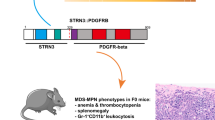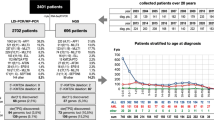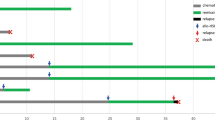Abstract
A 5-year-old boy who initially presented with ALL and relapsed 4 months later with AML was found to have an add(19) in the leukemia cells. FISH revealed that the add(19) was really a cryptic t(l2;l9)(p13.3;p13.3) interrupting E2A (TCF3). Nucleotide sequences of cloned genomic fragments with the E2A rearrangements revealed that the der(12) contained E2A joined to an intron of the NOLI (p120) gene. Reverse transcriptase (RT)–PCR of patient lymphoblast RNA showed expression of in-frame fusion cDNAs consisting of most of NOL1 fused to the 3′ portion of E2A that encoded part of the second transcriptional activation domain and the DNA binding and protein dimerization motifs. The reciprocal der(19) E2A genomic rearrangements included 5′ regions of E2A joined to an intron of the ZNF384 (NMP4, CIZ) gene, located approximately 450 kb centromeric to NOL1 on chromosome 12. RT–PCR showed expression of in-frame E2A-ZNF384 fusion cDNAs. To our knowledge, this is the second report of a chromosome translocation in leukemia resulting in two different gene fusions. This is the first report of expression of E2A fusion protein that includes the DNA binding and protein dimerization domains due to a more proximal break in E2A compared to those described previously.
This is a preview of subscription content, access via your institution
Access options
Subscribe to this journal
Receive 12 print issues and online access
$259.00 per year
only $21.58 per issue
Buy this article
- Purchase on Springer Link
- Instant access to full article PDF
Prices may be subject to local taxes which are calculated during checkout





Similar content being viewed by others
References
Hunger SP . Chromosomal translocations involving the E2A gene in acute lymphoblastic leukemia: clinical features and molecular pathogenesis. Blood 1996; 87: 1211–1224.
Nourse J, Mellentin JD, Galili N, Wilkinson J, Stanbridge E, Smith SD et al. Chromosomal translocation t(1;19) results in synthesis of a homeobox fusion mRNA that codes for a potential chimeric transcription factor. Cell 1990; 60: 535–545.
Kamps MP, Murre C, Sun XH, Baltimore D . A new homeobox gene contributes the DNA binding domain of the t(1;19) translocation protein in pre-B ALL. Cell 1990; 60: 547–555.
Hunger SP, Ohyashiki K, Toyama K, Cleary ML . Hlf, a novel hepatic bZIP protein, shows altered DNA-binding properties following fusion to E2A in t(17;19) acute lymphoblastic leukemia. Genes Dev 1992; 6: 1608–1620.
Inaba T, Roberts WM, Shapiro LH, Jolly KW, Raimondi SC, Smith SD et al. Fusion of the leucine zipper gene HLF to the E2A gene in human acute B-lineage leukemia. Science 1992; 257: 531–534.
Hunger SP, Devaraj PE, Foroni L, Secker-Walker LM, Cleary ML . Two types of genomic rearrangements create alternative E2A-HLF fusion proteins in t(17;19)-ALL. Blood 1994; 83: 2970–2977.
Yoshihara T, Inaba T, Shapiro LH, Kato JY, Look AT . E2A-HLF-mediated cell transformation requires both the trans-activation domains of E2A and the leucine zipper dimerization domain of HLF. Mol Cell Biol 1995; 15: 3247–3255.
Honda H, Inaba T, Suzuki T, Oda H, Ebihara Y, Tsuiji K et al. Expression of E2A-HLF chimeric protein induced T-cell apoptosis, B-cell maturation arrest, and development of acute lymphoblastic leukemia. Blood 1999; 93: 2780–2790.
Smith KS, Rhee JW, Naumovski L, Cleary ML . Disrupted differentiation and oncogenic transformation of lymphoid progenitors in E2A-HLF transgenic mice. Mol Cell Biol 1999; 19: 4443–4451.
Kamps MP, Look AT, Baltimore D . The human t(1;19) translocation in pre-B ALL produces multiple nuclear E2A-Pbx1 fusion proteins with differing transforming potentials. Genes Dev 1991; 5: 358–368.
Monica K, LeBrun DP, Dedera DA, Brown R, Cleary ML . Transformation properties of the E2a-Pbx1 chimeric oncoprotein: fusion with E2a is essential, but the Pbx1 homeodomain is dispensable. Mol Cell Biol 1994; 14: 8304–8314.
Dedera DA, Waller EK, LeBrun DP, Sen-Majumdar A, Stevens ME, Barsh GS et al. Chimeric homeobox gene E2A-PBX1 induces proliferation, apoptosis, and malignant lymphomas in transgenic mice. Cell 1993; 74: 833–843.
Brambillasca F, Mosna G, Colombo M, Rivolta A, Caslini C, Minuzzo M et al. Identification of a novel molecular partner of the E2A gene in childhood leukemia. Leukemia 1999; 13: 369–375.
Hunger SP, Sun T, Boswell AF, Carroll AJ, McGavran L . Hyperdiploidy and E2A-PBX1 fusion in an adult with t(1;19)+ acute lymphoblastic leukemia: case report and review of the literature. Genes Chromosomes Cancer 1997; 20: 392–398.
Mitelman F (ed). ISCN. An International System for Human Cytogenetic Nomenclature. S Karger: Basel, 1995.
Boomer T, Varella-Garcia M, McGavran L, Meltesen L, Olsen AS, Hunger SP . Detection of E2A translocations in leukemias via fluorescence in situ hybridization. Leukemia 2001; 15: 95–102.
Suryanarayan K, Hunger SP, Kohler S, Carroll AJ, Crist W, Link MP et al. Consistent involvement of the bcr gene by 9;22 breakpoints in pediatric acute leukemias. Blood 1991; 77: 324–330.
Mellentin JD, Murre C, Donlon TA, McCaw PS, Smith SD, Carroll AJ et al. The gene for enhancer binding proteins E12/E47 lies at the t(1;19) breakpoint in acute leukemias. Science 1989; 246: 379–382.
Ochs RL, Reilly MT, Freeman JW, Busch H . Intranucleolar localization of human proliferating cell nucleolar antigen p120. Cancer Res 1988; 48: 6523–6529.
Alvarez M, Long H, Onyia J, Hock J, Xu W, Bidwell J . Rat osteoblast and osteosarcoma nuclear matrix proteins bind with sequence specificity to the rat type I collagen promoter. Endocrinology 1997; 138: 482–489.
Nakamoto T, Yamagata T, Sakai R, Ogawa S, Honda H, Ueno H et al. CIZ, a zinc finger protein that interacts with p130(cas) and activates the expression of matrix metalloproteinases. Mol Cell Biol 2000; 20: 1649–1658.
Gorczyca W, Bruno S, Melamed MR, Darzynkiewicz Z . Cell cycle-related expression of p120 nucleolar antigen in normal human lymphocytes and in cells of HL-60 and MOLT-4 leukemic lines: effects of methotrexate, camptothecin, and teniposide. Cancer Res 1992; 52: 3491–3494.
Trere D, Migaldi M, Montanaro L, Pession A, Derenzini M . p120 expression provides a reliable indication of the rapidity of cell duplication in cancer cells independently of tumour origin. J Pathol 2000; 192: 216–220.
Perlaky L, Valdez BC, Busch RK, Larson RG, Jhiang SM, Zhang WW et al. Increased growth of NIH/3T3 cells by transfection with human p120 complementary DNA and inhibition by a p120 antisense construct. Cancer Res 1992; 52: 428–436.
Feister HA, Torrungruang K, Thunyakitpisal P, Parker GE, Rhodes SJ, Bidwell JP . NP/NMP4 transcription factors have distinct osteoblast nuclear matrix subdomains. J Cell Biochem 2000; 79: 506–517.
Thunyakitpisal P, Alvarez M, Tokunaga K, Onyia JE, Hock J, Ohashi N et al. Cloning and functional analysis of a family of nuclear matrix transcription factors (NP/NMP4) that regulate type I collagen expression in osteoblasts. J Bone Miner Res 2001; 16: 10–23.
Martini A, La Starza R, Janssen H, Bilhou-Nabera C, Corveleyn A, Somers R et al. Recurrent rearrangement of the Ewing's sarcoma gene, EWSR1, or its homologue, TAF15, with the transcription factor CIZ/NMP4 in acute leukemia. Cancer Res 2002; 62: 5408–5412.
Hunger SP, Zhong C . Cryptic t(12;19) in ALL with lineage switch to AML creates two new E2A fusion proteins. Blood 2002; 100: 529a (Abstract no. 2070).
Corveleyn A, Janssen H, Martini A, Somers R, Cools J, Marynen P . Cellular transformation of NIH3T3 fibroblasts by CIZ/NMP4 fusions. J Cell Biochem 2005; 94: 1112–1125.
La Starza R, Aventin A, Crescenzi B, Gorello P, Specchia G, Cuneo A et al. CIZ gene rearrangements in acute leukemia: report of a diagnostic FISH assay and clinical features of nine patients. Leukemia 2005; 19: 1696–1699.
van der Burg M, Poulsen TS, Hunger SP, Beverloo HB, Smit EM, Vang-Nielsen K et al. Split-signal FISH for detection of chromosome aberrations in acute lymphoblastic leukemia. Leukemia 2004; 18: 895–908.
Barber KE, Harrison CJ, Broadfield ZJ, Stewart AR, Wright SL, Martineau M et al. Molecular cytogenetic characterization of TCF3 (E2A)/19p13.3 rearrangements in B-cell precursor acute lymphoblastic leukemia. Genes Chromosomes Cancer 2007; 46: 478–486.
Tanabe S, Bohlander SK, Vignon CV, Espinosa III R, Zhao N, Strissel PL et al. AF10 is split by MLL and HEAB, a human homolog to a putative Caenorhabditis elegans ATP/GTP-binding protein in an invins(10;11)(p12;q23q12). Blood 1996; 88: 3535–3545.
Acknowledgements
This work was supported by grants from The American Cancer Society (LBC 97-463), the Loewenstern Family Foundation and the Pediatric Cancer Foundation to SPH and NCI Cancer Center Core Grant CA 46934.
Author information
Authors and Affiliations
Corresponding author
Rights and permissions
About this article
Cite this article
Zhong, Ch., Prima, V., Liang, X. et al. E2A-ZNF384 and NOL1-E2A fusion created by a cryptic t(12;19)(p13.3; p13.3) in acute leukemia. Leukemia 22, 723–729 (2008). https://doi.org/10.1038/sj.leu.2405084
Received:
Revised:
Accepted:
Published:
Issue Date:
DOI: https://doi.org/10.1038/sj.leu.2405084
Keywords
This article is cited by
-
Loss of SIRT1 inhibits hematopoietic stem cell aging and age-dependent mixed phenotype acute leukemia
Communications Biology (2022)
-
Epigenetic Regulation of Endothelial Cell Function by Nucleic Acid Methylation in Cardiac Homeostasis and Disease
Cardiovascular Drugs and Therapy (2021)
-
Detection of EP300-ZNF384 fusion in patients with acute lymphoblastic leukemia using RNA fusion gene panel sequencing
Annals of Hematology (2020)
-
Characterization of TCF3 rearrangements in pediatric B-lymphoblastic leukemia/lymphoma by mate-pair sequencing (MPseq) identifies complex genomic rearrangements and a novel TCF3/TEF gene fusion
Blood Cancer Journal (2019)
-
Overexpression of zinc finger protein 384 (ZNF 384), a poor prognostic predictor, promotes cell growth by upregulating the expression of Cyclin D1 in Hepatocellular carcinoma
Cell Death & Disease (2019)



